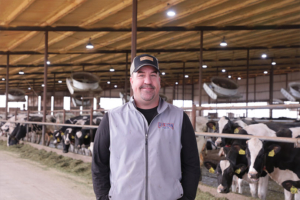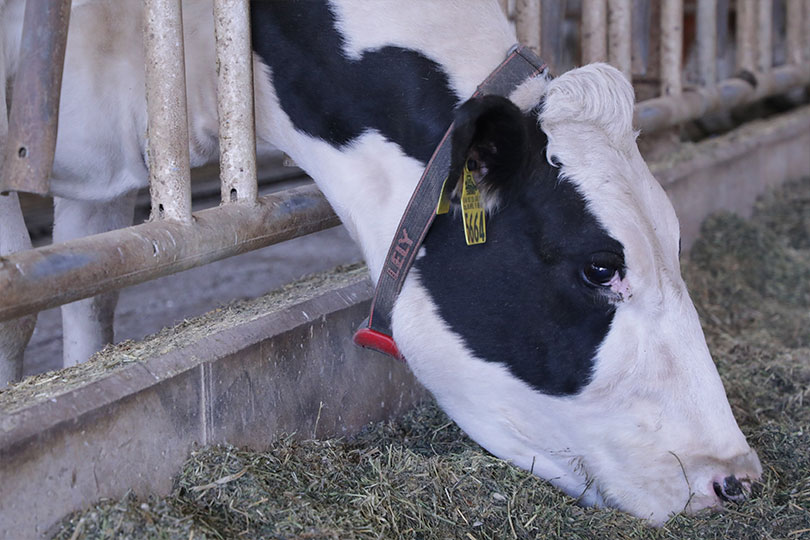By Shelby Shank
Field Editor
On Scott Vieth’s dairy farm in Windthorst, technology is key.
His cows are milked by a robot, ushering in a new era for dairy production for this third-generation dairy farmer.
Vieth made the decision in 2022 to switch to robotic milkers. His dairy is one of only six robotic dairies in the state, and most of them can be found in the Windthorst area.
“I started using the robots because my old parlor was getting old and outdated. I wanted to become more innovated and use the technology being used in the dairy industry,” Vieth said. “Genetics are a big thing for me, and I wanted to get the full genetic potential out of my cows. The robots give me the best option for that.”
In his old parlor, Vieth was reaching 80 pounds of energy–corrected milk, and since his switch to the robotic milkers, Vieths cows are now averaging 95 pounds of energy–corrected milk a day.
Veith installed nine Lely A5 robots underneath a climate controlled 100,000 square-foot tunnel vent barn. The climate-controlled barn creates a cooler environment for the cows during the hot Texas summers.
The robots also capture data through rumination collars the cows wear daily. The collars are essential for the robotic milkers because they communicate with the robot about the cow being milked. Like a FitBit, the robot reads the cow’s collar and provides the farmer with information about the cow, such as heat detection, animal health and how much milk the cow is producing.
“The robotic milker reads the collars as the cows come in to be milked, and if a cow has been in there in less than four hours, it automatically kicks them out because it is too soon for the cow to be milked again,” Vieth said. “What drives the cows to the robots are feed pellets I call cow candy. Depending on how much milk the cow produces, the robot determines the amount of pellets the cow is allowed to have. The cows love being in the robot for this reason.”
The robotic milkers work 24 hours a day, allowing the cows to come in as they please and as often as they want. Every cow gets milked at least twice a day and sometimes up to five times a day if the cow prefers.
Each robot can handle 60 cows and has allowed Vieth to grow his farm from 450 cows to 550 with one less employee.
The technology and willingness to adapt has allowed Vieth to maximize the efficiency of his farm.
“I think people hear machines or robots and they think there is a disconnect between the person and the animal. There isn’t. It’s taking on the best care for the animals,” Vieth said. “The cows really like the robots because they’re never stressed with their milk. If they’re coming in three or four times a day, then their bags are not stressed out like they normally would if you’re milking twice a day in a traditional parlor.”
The milking process begins when the cow enters the robotic milker, and their collar is read.
The robot drops the amount of feed the cow is allotted. The cow’s teats are cleaned with a brush and disinfectant before being milked.
A laser reads the cow’s teat placement before the robot connects to the cow’s teats and begins milking.

Once the cow is finished milking, the teats are sprayed with an orange dye that protects the teats. The cow is released back into the herd, and the next cow comes through.
Vieth, a Texas Farm Bureau member, noted there are usually two to three cows waiting to enter the robotic milker.
After the cows are milked, the liquid goes to the milk tank where it is chilled to 35 degrees. The quicker the milk gets cool, the longer its shelf life is.
After a day, the milk is shipped to Daisy to be used for sour cream and later distributed to a major restaurant chain.
Vieth’s cows are currently producing 5,500 gallons of milk a day.
The robotic milkers have given Vieth more production and helped him maximize the genetic potential of each cow. Vieth said his father was known for his farm’s genetics and was one of the leading dairy farmers in Texas and the country.
He hopes to carry on that same reputation.
“I think the biggest benefit of this type of technology is the fact that sometimes you have human error, and the robot eliminates that,” Vieth said. “I can go to my computer at any time of day or look at the app on my phone and see if a cow is sick or has any kind of problems.”
The robots allow Vieth’s schedule to be flexible and spend more time with his family, too.
The dairy industry has been a centerpiece for the Windthorst community. At one time, there were 100 dairies in the Windthorst and Scotland area, but those numbers have since declined.
“It’s been a big part of this community, and it’s sad to see some of the farms go over the years,” he said. “The dairy industry is a really competitive industry. If you don’t keep up with the times and technology, it’ll leave you behind.”
Vieth also has a Juno, which is like a Roomba for dairy cows, that pushes the feed up for the cows six times a day. As the cows tend to sort through their feed, the Juno comes down the rows and pushes the feed closer for the cows to continue eating.
The cows even have waterbeds to lay on after being milked.
Vieth’s dairy is a prime example of constant evolution of the dairy industry. Cow comfort, animal health and nutrition, efficiency and sustainability are key components of this important segment of Texas agriculture.
And it’s allowing him to carry on his family’s tradition of dairy farming.

